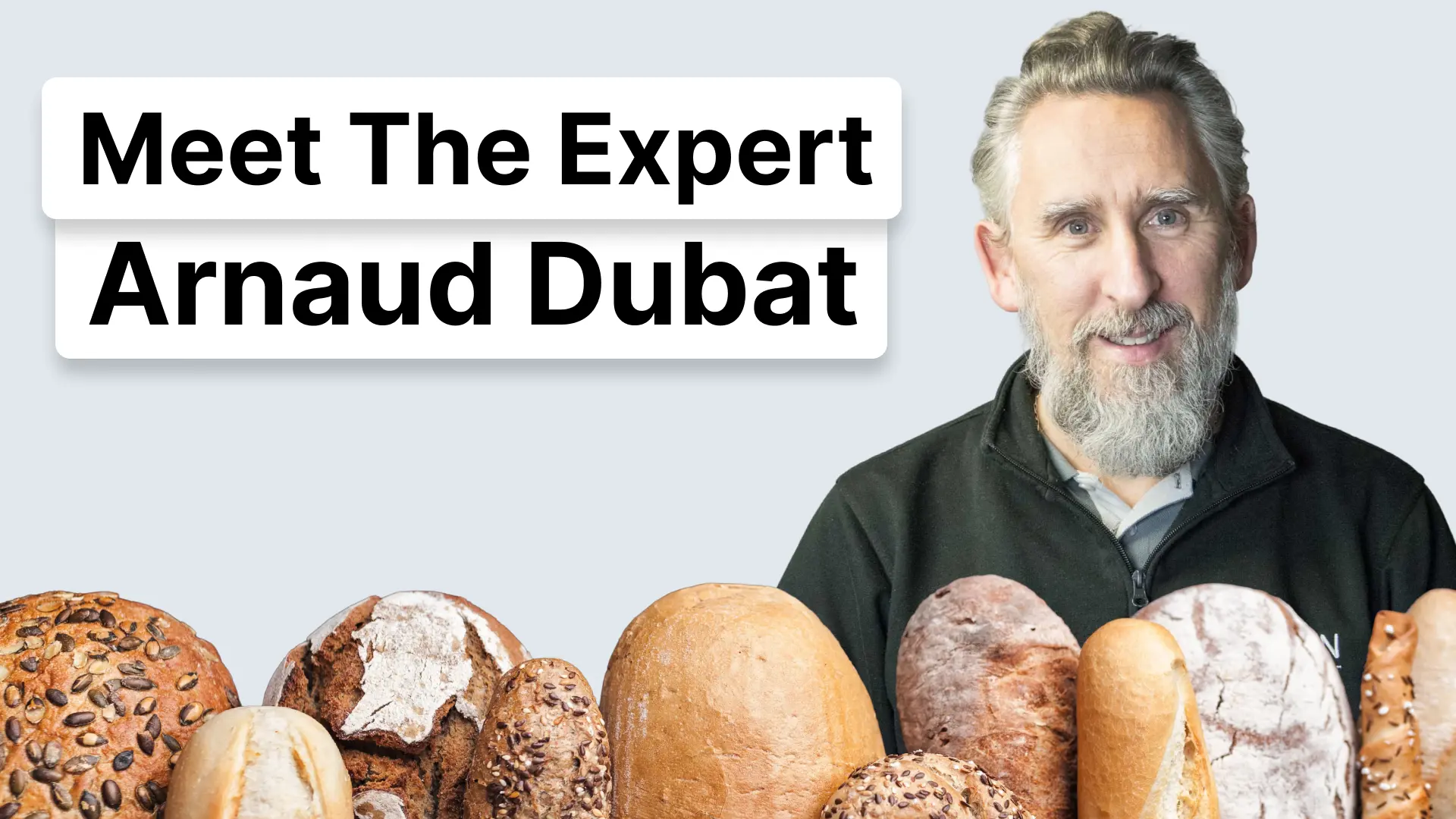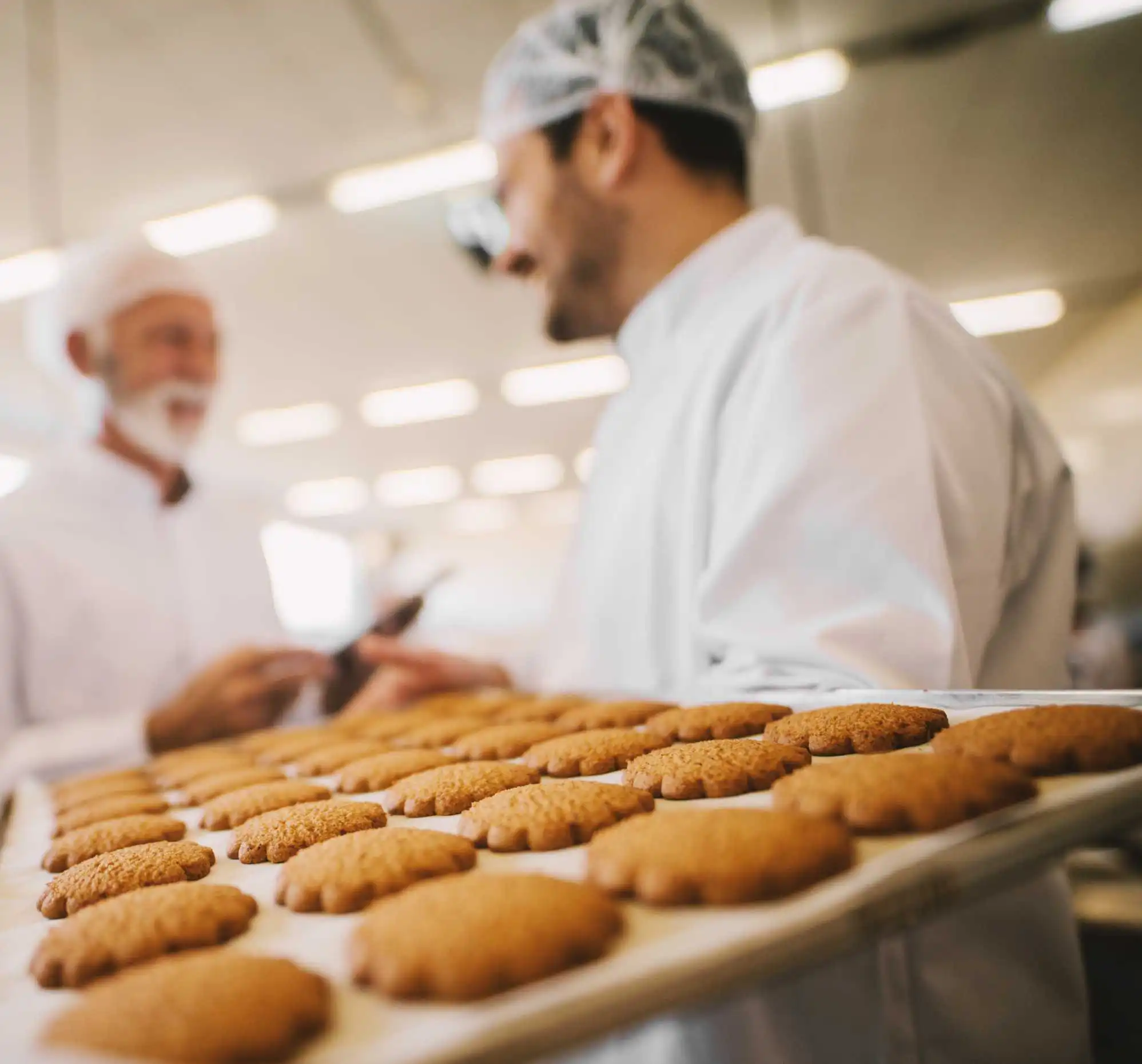Evolution of the Grain, Flour, and Bread World - a Personal View

When I was first asked to do this interview, I felt a bit strange, as I believed such a review would be biased coming from a subjective standpoint. Then I thought, why not? Even if partial, my experience might be interesting, and my intention is to share some lessons learned along the way with younger folks.
What is your background, and why did you choose this industry?
First, I must admit that I was not destined to work in the milling and baking industry before joining the French Milling School in 1987, after studying biochemistry in more depth. The first things that struck me when discovering this new world were the exciting balance between science and tradition, and the outstanding enthusiasm of our teachers. This has never stopped since… this industry is filled with enthusiastic people who can always teach you something new, anytime. Here are the top lessons I’ve learned over 36 years working in this industry.
Everybody speaks about “service.” How would you define “service”?
When I joined the CHOPIN Technologies, now a KPM Analytics brand, our job was to produce and service laboratory tools. At that time, service was important but limited to technical repair and maintenance of the equipment. In the mid-1990s, we observed a substantial change in the milling industry: most people developing applications and publishing their findings were no longer there. The industry was now concentrating on production, not on studying. So instead of having people develop new techniques on our devices, we were asked to help them by providing protocols, methods, and applications. At the same time, as we were exporting more of our instruments year after year, it became obvious that our customers expected more from us than just fixing their devices. To address this, we created the application laboratory in 1995. Starting slowly with two people, then three, it is today one of the key services, with engineers supporting our customers in their development processes and creating new solutions all around the world.
Service is key. Providing tools is easy; providing consistently high-quality tools is challenging, and only a few can deliver complete solutions.
How can changes in the market impact the service offer?
Sometimes you can have an idea and—particularly in France—you will eventually find people telling you that “it will not work” or that “it was tried before and failed.” As a new employee, this can be scary. Nevertheless, after a few years working in the service department, I noticed that requests for Alveograph maintenance always arrived just before the crop season. This created a lot of customer frustration because our service capacity was limited and based on a “first-come, first-served” basis. So, the idea was to spread the workload over the year by proposing preventative maintenance contracts at lower prices when done during the winter. I was lucky to have an incredibly good manager who told me, “Well, we tried before without success, but if you want to try again, I’ll support you.” And it worked great. Almost 30 years later, the program still exists. To be fair, it was not totally my doing. I was lucky to propose this to a market that was shifting toward quality assurance. Each company was recruiting quality managers under ISO standards, and this offer was a perfect match for them. Today, having a preventative maintenance program is a must for any company that is serious about its quality.
It’s not because something failed before that it will never work. If you believe in it, try again!
Speaking about innovation, are the big companies always more likely to implement it?
During a brief period, I worked as a salesperson. As we were launching a brand-new model of our dough proofing analyzer (RheoF3), I was intensively promoting it. I had already experienced some successes and some disappointments, particularly when trying to propose this tool to bigger companies, as I really thought (and still do) that this tool would be a perfect fit for them, especially at a time when bread improvers were changing the game in the industry. But decision processes were complicated.
On the other hand, I was quite impressed when the tiniest mill I had visited invested in the device. A few months later, I visited him to check if everything was OK. “More than OK,” he said, “I fixed most of my customers’ complaints thanks to this tool.” He then showed me the “reference graphs” on the wall for the three main types of flour he produced. He added, “If I manage to reproduce these graphs—and I do—the bakers are delighted with the flour consistency.” He was using it to select wheat, blend flour, and add the most suitable improver. Everything I thought would be a substantial win for a bigger company was proven true by the smallest of all.
If you are open to innovation, your size does not matter—you will make a difference!
Innovation requires a scientific foundation. What is your link with academia?
I see companies like ours as a bridge between fundamental science and the daily routine of the industry. Except for very large groups, where you can find many scientists working on different topics, most of our customers are dealing with production challenges. For them, fundamental research sometimes seems a bit “disconnected” or at least “too high-level.”
So, a big part of the service we bring our customers is based on the translation of scientific research into practical terms. Our application department is in charge of this. To be effective in this role, you need to learn (read papers, attend conferences), but you also need to show (presentations, posters, publications). And then you need to meet and engage.
My first international conference experience was in San Diego, CA, for an AACC meeting. Not only did I have to attend, but I was also scheduled to make a presentation. To add to the stress of presenting—in English—at the most important cereal meeting in the world, I quickly realized that most of the top scientists I had been learning from were present (Osborne, D’Appolonia, Faridi, Pomeranz, Medcalf, Morris… to name a few). For all these reasons, it was not the best talk of my life, but I was struck by the kindness, interest, and humility of these top scientists, which quickly made me feel part of the scientific community. Most of them became good friends, and more have joined through continuous involvement with AACC and ICC, resulting in many collaborations for the benefit of our customers (and still continuing today).
“If I have seen further, it is by standing on the shoulders of giants” (I. Newton). Learn from the best and always remember that you still have so much to learn.
But how does a new idea emerge?
By staying open and—maybe more importantly—curious. As I started traveling the world, I began discovering new ways of doing things. For example, during one of my first trips to Argentina, I was told they had a very strange (to me) way of producing bread—using a special slow mixer and an exceptionally long fermentation time (24 hours) supported by an extremely small amount of yeast (0.2%).
When I returned to France, I mentioned this to my managers because some users wanted to use the RheoF3 but could not, since our proofing time was limited to three hours. The answer (from someone who never left his office) was: “Impossible, you certainly misunderstood.” Since I knew it was possible, I waited for my next trip and confirmed that it was real (interestingly, it was adapted from the Italian Biga process). Based on this, we modified our instrument so it can now be used for proofing times of up to 24 hours.
There’s a saying I use to illustrate this way of thinking: “If I give you a dollar and you give me a dollar, at the end we each still have one dollar. If I give you an idea and you give me an idea, we both end up with two ideas… that will certainly create more.” I have always considered interacting with people as a unique opportunity to exchange ideas.
It’s not because you are unaware of something that it doesn’t exist. The market is always right.
It appears that you travel a lot. Why?
Yes, that’s a big part of my activity. Of course, being away from home is not always easy, but if you keep an open mind, it is always rewarding. I was lucky enough that my trips took me to many parts of the world to visit customers. These interactions have triggered a lot of ideas and opportunities that sometimes led to new product development (SDmatic, Mixolab, and Alveolab improvements all came from user comments) but also to many applications projects published in various forms (presentations, posters, books…).
And the good thing is, the more you do, the more you receive—comments, ideas—and the more you can continue. One of my mentors, Michel Dubois, used to speak about two types of marketing: “the walking one,” consisting of reaching information where it is and interacting with product makers, and “the seated one,” consisting of developing market knowledge from your office chair. For obvious reasons, the second type was not his favorite. He was 100% right.
Remember that in the late 1990s, remote access to information was limited (yes, the internet became mainstream at the beginning of the 2000s). But this is still valid today, even with the incredible access to information that innovative technologies bring us (ChatGPT, for example)—maybe even more so, to confront theory and reality.
Real life and valuable information lie in your customers’ facilities, not just in your reading.
Why is it so important to understand local preferences?
Because cereal-based products often mean a lot to people. They represent culture and identity. Some products might have gained special fame (like Italian pizza, Mexican tortillas, Indian naan…), but even so, these names cover an unlimited variety of forms, textures, and tastes.
This is why, when traveling, I always seek to taste local food—and particularly cereal-based products. Sometimes people are embarrassed to present a local bread to a Frenchman because of the reputation of the French baguette. Well, let me tell you something: I had one of my best baguettes in Japan, and I can still easily give you directions to buy terrible ones in Paris.
It is not because a croissant is different from the “French standard” (like in Argentina) that “they do not know how to make them” (as I have unfortunately heard too often from so-called “experts”). It’s just that local people like it differently.
So, if you start depreciating your customers because they are producing something different from your “reference,” you are completely wrong. Instead of judging, try to understand: Why do they like it this way? Is it consumer taste? Is it a technical reason (type of wheat available, etc.)? By staying open, you increase your chances to learn something new, to be surprised, and to grow.
You might like something or not, prefer one product over another, but always respect the person producing and consuming it.
Working for an innovative company, what is the main difficulty you have faced so far?
I mentioned earlier that this industry is a mix of science and tradition. It is also a mix of innovation and the strongest conservatism one can imagine. This is particularly true when it comes to laboratory control tools and protocols. By tradition, CHOPIN used to mostly serve millers.
When KPM Analytics acquired CHOPIN, and thanks to a new proximity with the EYEPRO and SIGHTLINE teams—experts in vision systems installed over bakery production lines—we started working more closely with bakers. This changed our perspective on quality control.
Of course, being a leader, we could have believed that what had been true for so many years would remain unalterable. But at the same time, we knew that sometimes “two flours with the same characteristics do not bake the same way.” Were we missing something?
Working more closely with bakers, we understood how each company—sometimes each production line—can be different from another. We could see how much the “guru-style” advice telling people what a “good flour” should look like is pointless without knowing the product, the process, the recipe, and the objective. Yet we still hear and read many describing a “good flour” (what is a “good” flour?) only in terms of protein content, water absorption… Users deserve better than this.
Because user satisfaction is our driving force, we started to objectively re-evaluate the situation and decided to resolutely step out of the many dogmas we had been fed (and sometimes repeated) for years. I honestly believe that the only way to improve is by not fearing to leave your comfort zone. What is the risk? If it doesn’t work, you can still return to your original approach. But if it works, you gain many steps ahead of your competitors.
Don’t take what you have been doing or hearing for years as unalterable—challenge yourself, think outside the box.
How does this “conservatism” appear when interacting with customers?
It can take many forms—even to the point of rejecting any innovation. One very recent conversation illustrates these barriers to change perfectly.
Meeting with a large biscuit manufacturer, we were told they had been trying for 20 years—working with the best mills and using conventional tools and protocols—to identify parameters that would improve their ability to separate well-performing flours from poor-performing ones. Like 96% of the industry, their specifications were protein-quality–oriented, leaving in the dark the 72% related to starch functionality.
So, we introduced the Mixolab for its ability to give a more holistic view of flour performance. The first question from the baker was, “And with the Mixolab, can I have equivalence with conventional tools?” I paused and said, “I don’t understand—you just told us that conventional tools regularly fail. We’re proposing to add (not replace) information that might help you find the missing part, and your first reaction is to try to obtain with this new tool what has been failing you for 20 years.”
The baker laughed and said, “Yes, you’re right, that’s not logical—let’s forget this question and see the potential.” This resistance to change is representative of a big part of the industry today, limiting companies’ development and leaving the field open for the more open-minded ones (remember the small miller with the Rheo).
If what you do now brings you 100% satisfaction, keep it. If not, try other options—be open.
How do you see the future for quality control?
I believe the time has come to break the chains that are limiting real improvement. I see three important moves already in progress.
The first move is technical. Our labs are full of great tools that are limited by protocols developed 100 years ago, when the world was totally different. I’m not saying “get rid of them”—of course not. I’m just saying that alongside the “old way,” there is a world of potential. This is a move where KPM, thanks to the application team, has already proposed solutions.
The second move is communication—exchanging information. It’s time to replace “feelings” with “data.” I can illustrate this with an example (I’ve had the same discussion many times). We were speaking with one of the world leaders in the baking industry about using the Mixolab to improve their flour specifications for millers. Like many, their COA (Certificate of Acceptance) was based on limited information (mostly protein-oriented), with limits set by “nobody remembers who or why” (but they keep applying them). The result is that flour sometimes works, sometimes it doesn’t.
The idea with the Mixolab is to take information from the production line to select “well-performing flours” and create a profile that can then be communicated to the miller. The lab people liked the idea but told us, “Well, the thing is, we don’t know if the flour is performing well or not.” The problem here was that there was no communication between QA and production. This is an easy fix: have the lab and the production work together on numbers. Learn from your production line and you’ll be in a much better position to communicate—and to get—what’s good for you from your miller.
The third move is intelligence—already here with the increasing presence of AI. To obtain effective answers, you need precise information (data). Production data can now be measured very precisely thanks to vision systems. Do we really believe that flour and dough QC will continue to rely on protocols set in 1930? At KPM, we don’t think so—and we are prepared for this revolution.
COAs are often useless until they are connected to reality. Bakers hold the truth, and we should listen to them. Stop guessing—start measuring.
If you had to summarize your experience in the cereal, flour, and bread industry, what would you say?
As I said in the beginning, this is a wonderful industry, filled with passionate people worth meeting and listening to.
In conclusion, I would say that, for me, the important part is human contact—human interactions. Always remember, when visiting someone, that you have two ears and one mouth. This is a simple reminder that you should be listening twice as much as you are speaking.
And yet, how many times have I attended a meeting where the first thing is to present our solutions, watching people unload a lot of information on poor customers who are wondering what we’re doing there and what the interest is for them? Now take a second and realize how arrogant it is to enter a company and pretend you know what’s good for them. Imagine someone coming to you and, before you say a word, explaining what you need to do your job better. What would you think of this person?
I must admit, I have been this guy—because I didn’t know, and I thought I needed to impress to be taken seriously. On the contrary, what about listening to the customer first? What about learning from them what they would like to improve? And then focusing on that point only?
Well, that is the difference between proposing tools and proposing solutions. And if there is one thing I have surely learned over these 30+ years, it’s that the second may be more challenging but is, for sure, more interesting—and ultimately the most rewarding for everyone.
Other Posts in the Series
Yes, the Mixolab has been equipped with the Simulator feature, which allows you to obtain data at all points equivalent (values and units) to the Farinograph®. This allows you to compare the data with partners or to have a first assessment of the wheat quality with a small sample size.
The Alveolab and AlveoPC are capable of working with all types of hard and soft wheats. The Alveolab can also measure whole wheat dough properties.
Yes, the milling process always causes a degree of damage to starch, but it is important to understand the level of damage and how it will affect the final product.
Related Blog Posts







.webp)








